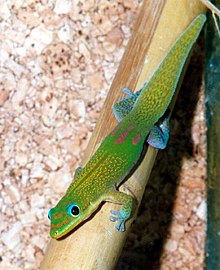
Back وزغية Arabic Gekkonlar Azerbaijani Геконавыя Byelorussian Геконови Bulgarian গেকোনিডি Bengali/Bangla རྩིགས་རྨིགས། Tibetan Jeko Breton Gecònids Catalan Ciēng CDO Tiki CEB
| Gecko Temporal range:
| |
|---|---|

| |
| Gold dust day gecko | |
| Scientific classification | |
| Domain: | Eukaryota |
| Kingdom: | Animalia |
| Phylum: | Chordata |
| Class: | Reptilia |
| Order: | Squamata |
| Infraorder: | Gekkota Cuvier, 1817 |
| Families | |
|
Pygopodidae | |
Geckos are small to middle size lizards. There are 1196 different species of geckos, mostly in the suborder Gekkota. They live in many warm countries and usually are active during the night.[2] Some kinds of geckos live in people's houses. Hemidactylus frenatus is the common house gecko. People are often happy to have them, because geckos eat many insects.
Unlike most lizards, geckos have voices. A gecko sounds a little like a bird or a frog. In some languages, these lizards have names that sound like their calls, for example, both English and Indonesian call one kind gecko (gek-KO) and tokay (to-KAY). Another kind of gecko, with a different sound, is called chicak (CHEE chak).
Most geckos lay eggs, but some give birth to live young.[2]
Geckos have no eyelids. Instead, they have a clear membrane (skin) over their eyes. They lick the membrane clean with their tongues.[3] Like most lizards, they can regenerate their tail if they need to. Their tail also helps them balance and store fat.[3] Geckos also shed their skin, like many other reptiles. Geckos are also able to replace their teeth every few months.
Geckos can walk on trees, walls, windows, and ceilings. Geckos' feet form a molecular bond with the surface that they are walking on in order to "stick" to the surface. This force is called van der Waal's force.They can do this because they have special toe pads. A microscope shows that each toe pad is made of thousands of hair-like structures called setae. Each of these structures branches into many smaller ends called spatulae.[4][5] The rest of their skin is also covered in extremely small hairs, which make it hard for a gecko to get wet. Gecko skin can also kill bacteria.[6]
- ↑ *Arnold, E.N.; Poinar, G. (2008). "A 100 million year old gecko with sophisticated adhesive toe pads, preserved in amber from Myanmar (abstract)" (PDF). Zootaxa. Retrieved August 12, 2009.
- Borsuk-Białynicka, M. (1990). "Gobekko cretacicus gen. et. sp. n., a new gekkonid lizard from the Cretaceous of the Gobi Desert". Acta Palaeontologica Polonica. 35 (1–2): 67–76.
- Conrad, Jack L.; Norell, Mark A. (December 1, 2006). "High-resolution X-ray computed tomography of an Early Cretaceous gekkonomorph (Squamata) from Öösh (Övörkhangai; Mongolia)". Historical Biology. 18 (4): 405–431. doi:10.1080/08912960600679570. S2CID 84796884.
- Conrad, Jack L. (June 3, 2008). "Phylogeny and Systematics of Squamata (Reptilia) Based on Morphology". Bulletin of the American Museum of Natural History. 310: 1–182. doi:10.1206/310.1. hdl:2246/5915. S2CID 85271610.
- Bauer, Aaron M.; Böhme, Wolfgang; Weitschat, Wolfgang (April 2005). "An Early Eocene gecko from Baltic amber and its implications for the evolution of gecko adhesion". Journal of Zoology. 265 (4): 327–332. doi:10.1017/S0952836904006259.
- ↑ 2.0 2.1 "gecko | Species & Facts". Encyclopedia Britannica. Retrieved March 12, 2019.
- ↑ 3.0 3.1 "Gecko". National Geographic. Archived from the original on March 27, 2019. Retrieved March 10, 2019.
- ↑ "Geckos may be famously sticky, but here's what stumps them". National Geographic News. July 9, 2016. Retrieved March 12, 2019.
- ↑ Autumn, Kellar; et al. 2002. Evidence for van der Waals adhesion in gecko setae. PNAS 99: 12252–12256
- ↑ Watson, Gregory S.; Green, David W.; Schwarzkopf, Lin; Li, Xin; Cribb, Bronwen W.; Myhra, Sverre; Watson, Jolanta A. (July 2015). "A gecko skin micro/nano structure - A low adhesion, superhydrophobic, anti-wetting, self-cleaning, biocompatible, antibacterial surface". Acta Biomaterialia. 21: 109–122. doi:10.1016/j.actbio.2015.03.007. ISSN 1878-7568. PMID 25772496.